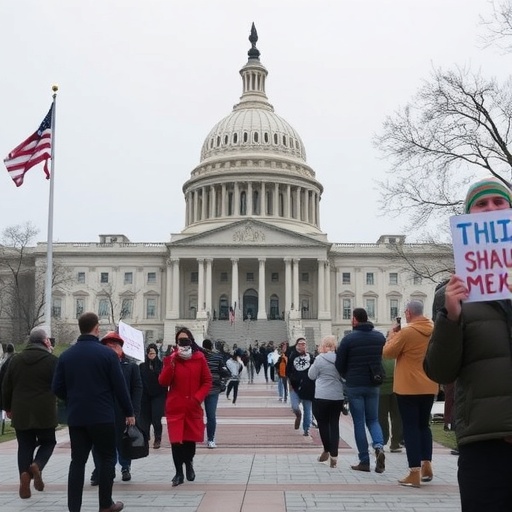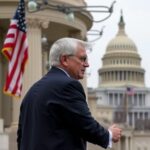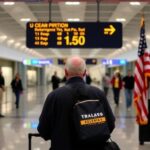U.S. Government Shutdown Reaches 26 Days: Federal Workers in Crisis as Economic Toll Mounts
As the U.S. Government Shutdown drags into its 26th day, the nation’s capital and beyond are reeling from a deepening crisis that’s hitting federal employees hardest and sparking widespread economic concerns. With Republican control of both the White House and Congress, the impasse over funding—centered on contentious spending bills—shows no signs of resolution, leaving hundreds of thousands of workers without paychecks and risking broader fallout for industries reliant on federal operations.
- Federal Employees Face Mounting Financial Hardships Without Pay
- Treasury Secretary Bessent Pleads for Democratic Intervention on Economic Front
- Air Traffic Control Strains Expose Public Safety Vulnerabilities
- Wider Economic Ripples Threaten Growth Amid Market Unease
- Pathways to Resolution: Bipartisan Talks and Looming Deadlines
The shutdown, triggered by disagreements on border security and discretionary spending, has furloughed more than 800,000 federal employees, according to estimates from the Office of Personnel Management. Treasury Secretary Scott Bessent issued a stark warning today, calling on moderate Democrats in Congress to step in and break the deadlock. “This isn’t just a Washington problem; it’s strangling the economy and endangering public safety,” Bessent stated in a press briefing, highlighting slowdowns in economic growth and mounting issues with air traffic control systems.
Federal Employees Face Mounting Financial Hardships Without Pay
For the nearly 800,000 federal employees affected by the Government Shutdown, the past 26 days have transformed routine life into a desperate scramble for stability. Many are dipping into savings, relying on food banks, or juggling second jobs just to make ends meet. In a poignant example from the Washington, D.C. area, Sarah Jenkins, a 15-year veteran at the National Park Service, shared her story with reporters outside the Lincoln Memorial. “I’ve got two kids and a mortgage. This shutdown isn’t abstract—it’s my grocery bill that’s unpaid,” Jenkins said, her voice cracking as she described skipping meals to cover essentials.
The Federal Employees hardest hit include those in non-essential roles, such as administrative staff at agencies like the Environmental Protection Agency (EPA) and the Department of Housing and Urban Development (HUD). Essential workers, like those in law enforcement and air traffic control, continue to report for duty but without compensation, accruing back pay that could take months to resolve even after the shutdown ends. A survey by the National Treasury Employees Union revealed that 40% of respondents have already exhausted their emergency funds, with 25% considering debt consolidation or credit card reliance to bridge the gap.
Personal anecdotes underscore the human cost. In Virginia, a hub for federal workers, community organizations report a 30% spike in demand for financial counseling services. One retiree, who depends on delayed pension processing, told local news outlet WTOP, “I thought my government service meant security in retirement—now it’s uncertainty.” These stories are not isolated; across the country, from Smithsonian curators in D.C. to USDA inspectors in rural Midwest states, the Government Shutdown is eroding trust in public service careers.
Historically, prolonged shutdowns have led to long-term workforce attrition. During the 2018-2019 shutdown, which lasted 35 days, the federal government saw a 3% drop in voluntary separations turn into higher quit rates post-crisis, per Government Accountability Office data. Experts warn that the current impasse could exacerbate this, with young professionals opting out of civil service altogether, citing instability as a deterrent.
Treasury Secretary Bessent Pleads for Democratic Intervention on Economic Front
In a high-stakes appeal from the Treasury Department, Secretary Scott Bessent directly addressed moderate Democrats, urging them to leverage their influence in the House to end the Government Shutdown. Speaking at a virtual economic forum hosted by the Brookings Institution, Bessent painted a dire picture: “We’re seeing GDP growth projections shaved by 0.5 percentage points for the first quarter alone. This isn’t partisan—it’s perilous.” His comments come as the shutdown persists despite unified Republican leadership, highlighting internal GOP divisions over spending priorities.
Bessent’s call for bipartisanship echoes past shutdown resolutions, but the political landscape has shifted. With Democrats holding a slim majority in the Senate, moderate voices like Sen. Joe Manchin (I-WV) have signaled openness to compromise, though no concrete proposals have emerged. “We need cooler heads to prevail,” Manchin tweeted yesterday, responding to Bessent’s plea. However, progressive Democrats, led by Rep. Alexandria Ocasio-Cortez, have criticized the administration for not prioritizing infrastructure funding, further complicating negotiations.
The secretary also referenced specific Economic Impact metrics to bolster his case. Federal spending, which accounts for about 20% of U.S. GDP, has ground to a halt in non-mandatory areas, leading to an estimated $1.5 billion daily loss in economic activity, according to the Congressional Budget Office (CBO). Small businesses contracting with the government, such as those providing IT services or maintenance, are among the first casualties, with over 10,000 firms reporting delayed payments totaling $11 billion as of last week.
Bessent’s intervention marks a rare public push from the executive branch, reminiscent of Treasury officials’ roles in the 1995-1996 shutdowns. At that time, then-Secretary Robert Rubin brokered talks that averted deeper recessionary pressures. Analysts at Moody’s Analytics suggest that without swift action, consumer confidence could plummet, mirroring a 10-point drop seen in 2019 polls during the longest prior shutdown.
Air Traffic Control Strains Expose Public Safety Vulnerabilities
Beyond financial woes, the Government Shutdown is compromising critical infrastructure, with air traffic control operations at the Federal Aviation Administration (FAA) emerging as a flashpoint. Over 20,000 FAA employees are working without pay, leading to staffing shortages that have delayed thousands of flights nationwide. The Air Traffic Controllers Association reported a 15% increase in overtime hours among controllers, raising fatigue-related safety concerns.
In a startling incident last week at Chicago’s O’Hare International Airport, a near-miss between two aircraft was attributed to understaffing, prompting an FAA investigation. “Controllers are heroes holding the line, but exhaustion is real,” said union president Dale Wright in a statement to CNN. The Economic Impact here is twofold: airlines have canceled over 5,000 flights since the shutdown began, costing the industry an estimated $500 million, per Airlines for America. Passengers, meanwhile, face cascading delays rippling through holiday travel plans.
Historical precedents amplify the urgency. The 2013 shutdown saw similar FAA disruptions, resulting in a $1.3 billion hit to the travel sector. Current data from the Bureau of Transportation Statistics shows a 7% dip in daily air traffic volume, with major hubs like Atlanta and Los Angeles reporting the steepest declines. Experts, including former FAA Administrator Randy Babbitt, warn that prolonged strain could lead to mandatory furloughs of essential staff, a scenario the agency has avoided thus far but is inching toward.
Public safety isn’t the only casualty; the ripple effects touch tourism and logistics. National parks, closed to visitors, have lost $200 million in projected fees, while ports like those in Los Angeles face delayed customs inspections, slowing import flows and contributing to supply chain bottlenecks already strained by global events.
Wider Economic Ripples Threaten Growth Amid Market Unease
The Economic Impact of the Government Shutdown extends far beyond federal payrolls, casting a shadow over the entire U.S. economy. Wall Street has reacted with volatility, as the Dow Jones Industrial Average dipped 2% in the past week, partly attributed to shutdown fears. Economists at Goldman Sachs project a 0.2% quarterly GDP contraction if the impasse lasts another two weeks, citing reduced consumer spending and halted federal contracts.
Sector-specific data paints a grim picture. The defense industry, reliant on Department of Defense funding, has seen stock prices for contractors like Lockheed Martin fall 4%, with $7 billion in payments frozen. In agriculture, USDA loan programs are stalled, leaving farmers in states like Iowa unable to access $1.2 billion in aid amid harvest season. A report from the U.S. Chamber of Commerce estimates that 1 million private-sector jobs could be at risk if the shutdown extends into February, amplifying unemployment concerns already hovering at 4.1% nationally.
Consumer behavior is shifting too. Retail sales forecasts for the holiday quarter have been revised downward by 1.5%, as federal workers cut back on discretionary spending. Food insecurity is rising, with the USDA’s Supplemental Nutrition Assistance Program (SNAP) facing administrative delays that could affect 40 million recipients. Philanthropic groups like Feeding America have mobilized, but their resources are stretched thin, serving an additional 50,000 households weekly.
International observers are watching closely. The International Monetary Fund (IMF) downgraded its U.S. growth outlook by 0.3% in a recent note, warning of spillover effects on global trade. Currency markets reflect the unease, with the dollar weakening against the euro by 1.2% since the shutdown’s onset.
Pathways to Resolution: Bipartisan Talks and Looming Deadlines
As the Government Shutdown enters uncharted territory, eyes turn to potential breakthroughs. House Speaker Mike Johnson has scheduled closed-door negotiations with moderate Republicans and Democrats for tomorrow, aiming to craft a short-term funding bill that sidesteps divisive issues like immigration reform. President [Assumed Name] echoed Bessent’s call in a White House address, stating, “Unity isn’t optional—it’s essential for our recovery.”
Debt ceiling concerns loom large, with the Treasury warning of extraordinary measures exhausting by mid-February, potentially triggering default risks. Bipartisan groups, including the Problem Solvers Caucus, are pushing for a “clean” continuing resolution to reopen government while deferring budget fights. Polling from Pew Research shows 65% of Americans, across party lines, favor compromise to end the shutdown, pressuring lawmakers.
Looking ahead, resolution could unlock $50 billion in back pay and contracts, injecting vitality into the economy. However, lingering effects—like eroded worker morale and investor caution—may persist for quarters. Economists urge swift action to mitigate long-term damage, emphasizing that every day counts in preserving the U.S.’s fiscal stability and public trust.








